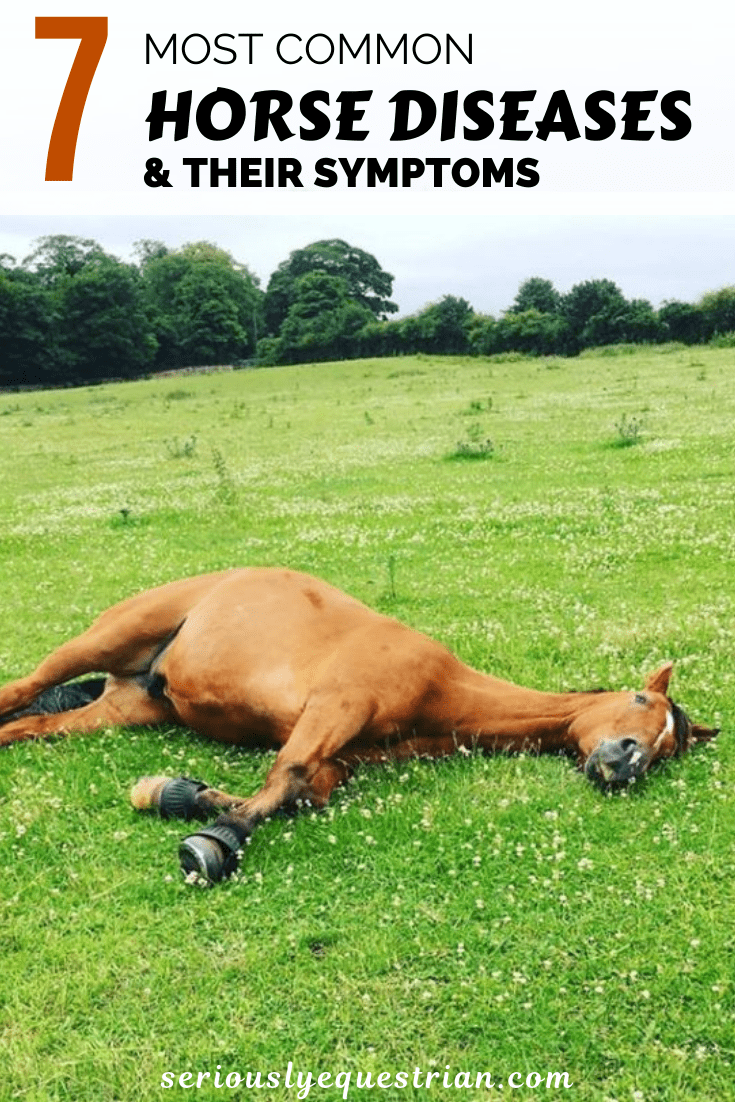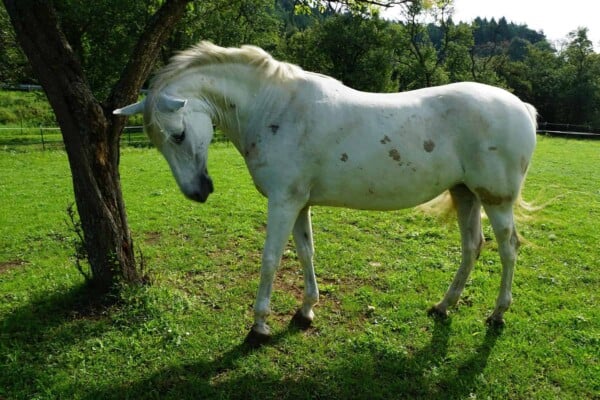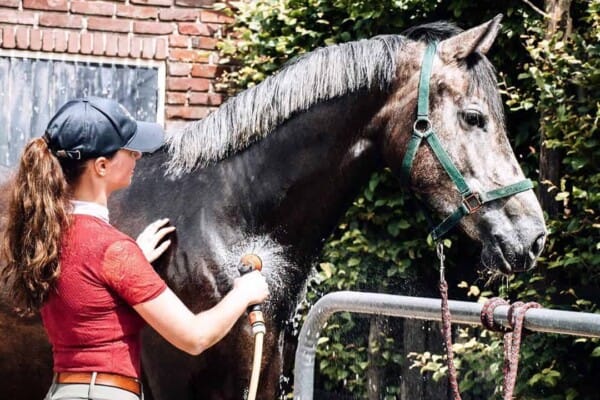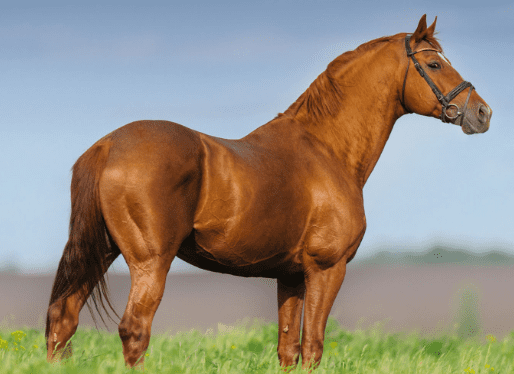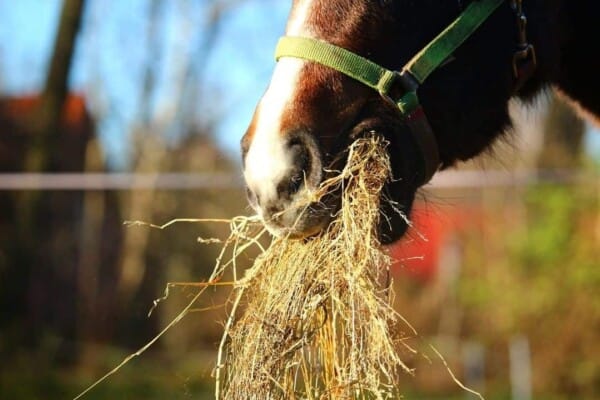Horses are afflicted by several diseases. Some are treatable and don’t have lasting effects, while others can mean the end of their sports career or even life. Not all diseases are common, so you rarely have to worry about them. However, there are diseases that every horse owner should be aware of. Here are some of the most common diseases that affect horses.
Laminitis
Laminitis is a disease that puts fear into horse owners. It is an extremely painful condition of the hoof that affects hundreds of horses daily. However, while not all cases are preventable, some are with correct diet management. So what is this common, potentially life-ending disease?
The foot consists of laminae, a structure that secures the hoof wall to the coffin joint. When blood flow to the laminae is interrupted laminitis occurs. This causes inflammation, which weakens the laminae. When this weakness happens, the coffin joint can separate from the hoof wall causing the joint to rotate. In severe cases, the joint rotates downward and can potentially break through the sole of the hoof.
Laminitis has several causes. The most common is diet-related. Overfeeding grain, sugary treats or access to too much lush grass after a period of no grass are all triggers. Horses that are overweight or receive a diet high in carbohydrate grain have a higher risk. Colic or illness that causes high fever can also cause laminitis. The disease occurs more frequently in the front feet.
Signs of acute and chronic laminitis
- Heat in the feet
- Lameness
- Digital pulse increase in the foot
- Standing with front feet stretched out in front of the body to relieve pressure, while the back feet are under the body
- Cresty neck
- Seedy toe
- Dropped soles
- Reluctance to move
Common cold and equine influenza
Just like humans, horses can get a cold or flu. These upper respiratory infections are caused by viruses and bacteria. Young horses that are still building their immune systems are especially susceptible. The disease spreads through contact or droplets secreted into the air, depending on the strain.
Signs of a cold:
- Cough-from dry to very moist
- Fever
- Runny nose/nasal discharge-clear to yellow or white
- Loss of appetite
- Unusual Lethargy
Degenerative Joint Disease (DJD)
Degenerative Joint Disease, also known as Osteoarthritis, is one of the most common causes of lameness. It is often seen in sport horses and can negatively affect their careers. DJD does not happen suddenly but progresses over time.
The bones of the joints are protected by cartilage and synovial fluid. The disease begins when inflammation occurs in the synovial membrane. The breakdown of cartilage begins after the inflammation. It most commonly affects the hocks, knees, and fetlocks. 15 percent of all lameness in horses can be contributed to DJD of the hock.
Signs of Degenerative Joint Disease:
- Reduction in level of performance
- Stiffness, especially after rest or when the weather is cold
- Loss of muscle
- Temperament changes
- Difficulty getting up or down
- Swollen joints
- Heat in the joints
- Lameness – this can be subtle
- Change in movement
West Nile Virus

West Nile Virus affects both humans and horses. It is the most common disease spread by mosquitoes in the US. It is a serious disease that requires intensive veterinary treatment as it affects the central nervous system. The mortality rate is 33%, with up to 40% of horses left with long-term effects. Horses cannot spread the disease to other horses.
A vaccination for horses is available and must be kept up to date. If the horse is exposed to the virus before it is vaccinated or has built up immunity, it will not have protection. It is not worth risking your horse’s life, so follow the vaccination protocol as soon as the horse is old enough.
Signs of West Nile Virus:
- Loss of appetite
- Depression
- Fever, though not all cases have a fever
- Ataxia – stumbling, lack of coordination, staggering
- Hind limb weakness
- Muscle twitching
- Lying down more, unable to stand
- Moving in circles
- Limb paralysis
- Lip droop
- Death
Lyme Disease
Lyme Disease is a tick-borne disease that gets its name from the town of Old Lyme, Connecticut, where it was first discovered. Horses living in certain areas, such as the Northeast US, are at higher risk. There is currently no vaccine.
It can be a difficult disease to diagnose as symptoms shift and also resemble other illnesses.
Each horse can present with symptoms differently. It can have long term effects on joints, neurological systems, skin, and vision that do not show for months, even years after infection.
Unless you discover the tick that bit your horse, testing for the disease is difficult. Blood tests look for antibodies. However, it can take several weeks for the right antibodies to build up, causing false positives or negatives.
Signs of Lyme Disease:
- Lameness – This can shift from leg to leg on different days.
- Depressed
- Lack of energy
- Cranky and sensitive to grooming when usually not
- Stiffness of joints
- Unwillingness to work
- Joint swelling
- Weight loss
- Eye inflammation
Cushings
Cushings disease is the common name for a hormonal disorder affecting the pituitary gland. It is also called PPID. The pituitary gland is located at the base of the brain. It creates steroid hormones when signals are received from the brain. When the pituitary gland is compromised, it no longer regulates these hormones correctly, resulting in too many circulating in the body.
The disease primarily affects older horses. It is one of the most common causes of laminitis. Early detection means better results from treatment.
Signs of Cushings:
- A long coat that often curls and does not shed out properly
- Weight loss
- Excessive drinking, which leads to increased urination
- Lethargy
- Fat deposits where they shouldn’t be
- More risk of contracting infections
- Laminitis
- Loss of topline
- High insulin levels
Strangles
The word strangles strikes fear into the heart of anyone involved in horses. Strangles is an upper respiratory infection that is extremely contagious. It does not discriminate based on horses age, color, overall health, or the value of the horse. Strangles is caused by the Streptococcus equi bacteria, which infects the lymph nodes of the horse.
An infected horse, along with the entire barn where it lives, must be put in isolation. No horses can come in or out until given the all-clear by a vet. Treatment consists of supportive care and letting the infection run its course. Care includes administration of anti-inflammatory drugs, hot compressing the abscesses that form around the jaw, and occasional antibiotics.
Signs of Strangles:
- Head and neck lymph node abscesses
- Coughing
- Difficulty swallowing
- Fever, sometimes high
- Snotty nose
- Loss of appetite
- Depression
The seven common diseases listed here are by no means all illnesses that can affect the horse. However, they are certainly seen frequently by horse owners. With knowledge of the signs, many diseases can be treated with positive outcomes.



